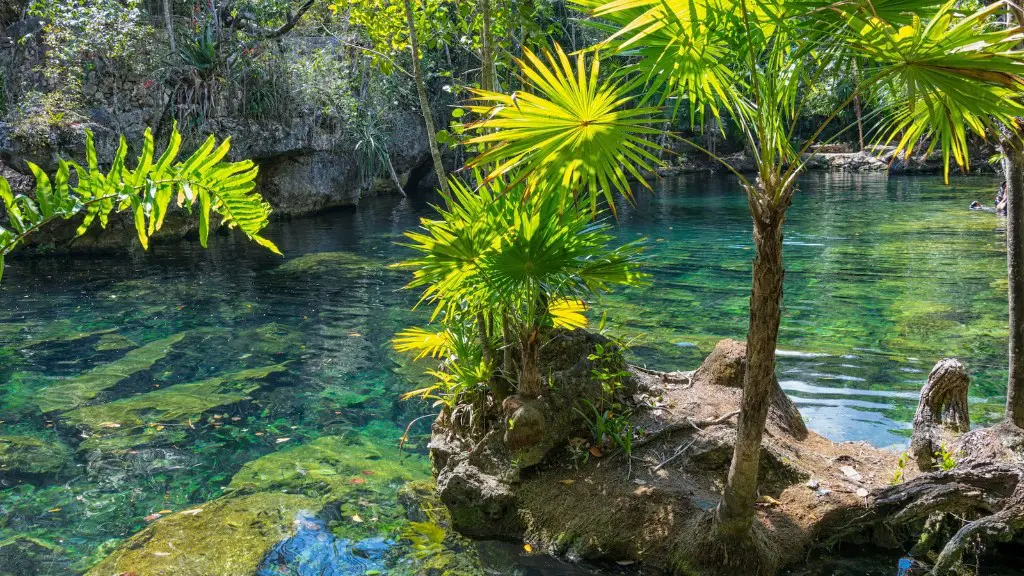Nearly 15 million Americans rely on drinking water that is sourced from the Mississippi River. This colossal river is an incredible environmental wonder that has potential health risks for those that drink it. These risks are due to chemical pollutants, poor water filtration, and even direct human waste from poorly managed septic systems. To understand the potential harm drinking Mississippi River water can do, it is important to familiarize ourselves with the types of water present in the river.
The Mississippi River consists of two types of water sources: fresh and salt. Freshwater is generally sourced from snow melt from the Upper Great Lakes, precipitation from the Northern regions, ice-covered lakes and streams, and even wetlands. This type of water is generally cleaner, with fewer pollutants and contaminants. It is not always free from industrial runoff and agricultural chemical pesticides, though, so care must be taken when consuming it.
Saltwater, on the other hand, is sourced from the Gulf of Mexico. This type of water is significantly more polluted with industrial and agricultural chemicals, due to its exposure to the Gulf’s nutrients and high temperatures. As this type of water travels up the Mississippi, it carries these pollutants with it and has the potential to be a health concern if not properly treated. While the exact levels of pollutants can vary from year to year, the Environmental Protection Agency has warned that it is generally safe to drink Mississippi River water, as long as it has undergone proper filtration.
The potential pollutants that can be found in the Mississippi River are quite varied. Agricultural and urban runoff, as well as industrial chemicals, can all reach the river and increase levels of chemicals such as nitrogen, phosphorus, and even heavy metals including lead and mercury. Additionally, runoff from sewage systems, septic tanks, and other sources of human waste can also enter the river and increase the levels of bacteria and viruses.
Despite the potential health risks posed by contaminated water, there are also many benefits that come from living in close proximity to the river. The Mississippi River provides essential habitat for a wide variety of species of plants, animals, and birds. Additionally, the Mississippi is a vital source of water resources for industries, agriculture, and the millions of people who live in the watershed. Moreover, the Mississippi River has been an integral part of United States history, providing a route of travel and transportation and serving as a lifeline for millions of people in the region.
Role of Filtering and Treatment
In order to safeguard against potential health risks posed by Mississippi River water, it is absolutely essential that cities, industries, and individuals take steps to ensure that the water is properly filtered and treated. Proper filtration removes potentially harmful microorganisms and pollutants that can be found in the river’s water, making it safe to drink and use.
It is also important to note that cities, industries, and individuals must be mindful of how the water is treated. If the water is not treated properly, then the health risks posed by contaminants can become very severe. For example, improperly treated wastewater can increase the levels of bacteria and viruses in the water, creating an environment ripe for the spread of disease.
Therefore, it is absolutely essential that cities, industries, and individuals take steps to ensure that the water is properly filtered and treated. This includes the use of specialized filtration systems that are designed to remove specific contaminants and pollutants from the water. Additionally, there are various types of treatment systems available, such as chlorination and ultraviolet light, that can further reduce levels of microorganisms and pollutants in order to make drinking water safer and of better quality.
Conclusion of Water Quality
Understanding the kinds of water present in the Mississippi River is key to determining its quality and safety as a drinking source. By understanding the different types of water, the pollutants and contaminants that may be present, and the proper methods of filtration and treatment, millions of Americans can continue to rely on the Mississippi River as a safe and dependable water source.
Conservation Methods
In order to guarantee that the Mississippi River’s water remains safe and healthy for the foreseeable future, cities, industries, and individuals must take responsibility for the water’s preservation. This means adopting and implementing conservation methods that are designed to minimize waste, reduce the use of pollutants, and control the spread of sewage and septic systems. These techniques can be as simple as planting native vegetation that is known to absorb pollutants from the river or installing water treatment systems that can reduce the levels of contaminants in the water.
Additionally, many cities and industries are investing in green infrastructure solutions to make sure any runoff from their facilities or surrounding areas does not end up polluting the river. These solutions often include buffer zones, constructed wetlands, and other structures that are designed to filter pollutants out of the water before they have a chance to enter the river.
It is also important to note that cities, industries, and individuals should work together to promote sustainable practices that will keep the river clean. This includes implementing laws and regulations that are designed to protect the Mississippi River and its water sources as well as providing education and outreach to the public on the importance of conservation and proper management of water sources.
Environmental Impact
In addition to the potential health risks posed by Mississippi river water, there are several environmental impacts associated with drinking it as well. The pollutants and contaminants that enter the river can disrupt the delicate balance of the ecosystem, making it difficult for the local species to survive. Additionally, poor water quality can also lead to eutrophication, or environmental degradation caused by an abundance of nutrients and pollutants. Furthermore, when people drink contaminated water, they can become exposed to a wide range of chemicals and microorganisms that can cause serious health risks.
In order to ensure the health of the Mississippi River, it is important to limit the amount of pollutants and contaminants entering the water. This can be done through initiatives such as green infrastructure, better wastewater management, and the implementation of stringent laws and regulations. Additionally, it is essential that individuals, businesses, and municipalities take responsibility for their actions and do their part to reduce their impact on the river.
Not only does this help to protect the environment, but it can also prevent the potential risks posed by contaminated water. By taking these steps, we can provide the people of the Mississippi River region with clean and safe drinking water that is free from pollutants and contaminants.
Public Health and Education
With millions of individuals relying on the Mississippi River for their drinking water, it is important to ensure that those consuming it understand the potential risks posed by pollutants and contaminants. This means providing education and outreach to the public in order to emphasize the importance of water conservation, filtration, and proper wastewater management. Additionally, municipalities and other stakeholders must be held accountable for practices that can pollute and degrade the river’s water.
Furthermore, providing access to clean and safe drinking water is essential for the health of those living in the watershed. In order to guarantee that everyone has access to this vital resource, there must be proper infrastructure in place to adequately filter and treat the water. This includes investing in municipal water treatment plants and upgrading existing ones to remove contaminants and pollutants from the water. Additionally, it is essential that those providing drinking water to the public ensure it is safe and that proper filtration and treatment are in place.
By taking steps to ensure proper management of water sources and providing the public with access to clean and safe drinking water, we can protect the health of those relying on the Mississippi River for their drinking water and the health of the river itself.





5 thoughts on “What Kind Of Water Is In The Mississippi River”